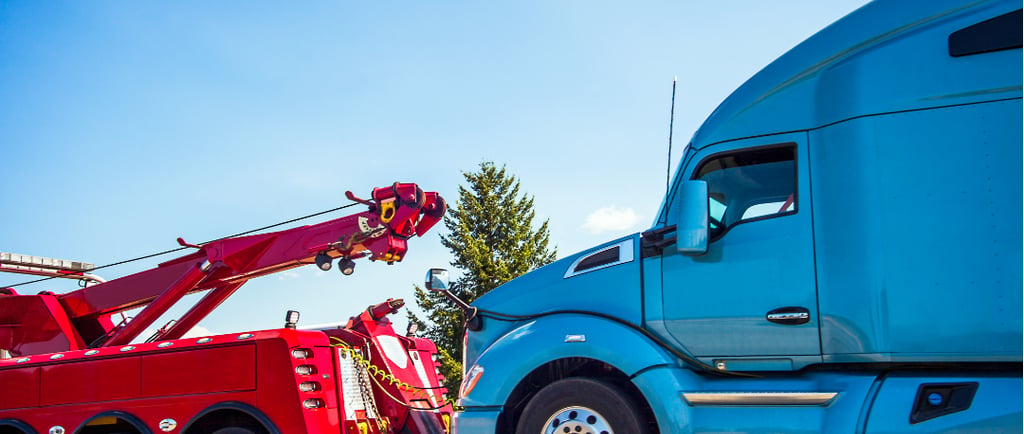How to Take Care of Your Drivers During a Breakdown
Breakdowns are more than mechanical issues—they’re human ones. Learn how to support your drivers physically, mentally, and emotionally when the unexpected happens.
6/26/20257 min read


When your fleet is struck by a breakdown, the impact goes far beyond a disabled truck. What appears to be a mechanical issue quickly turns into a deeper disruption that affects the driver behind the wheel—physically, mentally, and emotionally.
Physically, drivers may be left sitting in extreme heat or cold, with no access to food, restrooms, or a safe place to rest—often for hours. Mentally, the stress of not knowing when help will arrive or what happens next creates a sense of uncertainty, isolation, and even fear. Emotionally, these experiences can shake a driver’s confidence, leaving them anxious, frustrated, or questioning their value to the company. Over time, these moments add up—impacting performance, safety, morale, and eventually leading to burnout or turnover.
At My Fleet Assist, we understand that breakdowns aren’t just operational disruptions—they’re human ones. That’s why we prioritize fast response times, clear communication, and proactive support to keep your drivers informed, safe, and confident—because when drivers feel supported, they stay focused, stay loyal, and keep your business moving forward.
Why Driver Well‑Being During Breakdowns Matters
Stress amplifies safety and cost risks
According to FreightWaves, driver stress increases accident risk, aggressive driving, fuel inefficiency, and even turnover—translating into higher fuel, maintenance, insurance, and recruitment costs
Drivers under stress are:
10–40% less fuel efficient
More likely to exhibit risky behavior
Twice as likely to be involved in a crash
One-third to consider quitting within the year
According to the American Trucking Associations (ATA), replacing a single truck driver can cost between $8,000 and $12,000, depending on recruiting, onboarding, training, and lost productivity during vacancies. Obviously, it’s not only the right thing to do, but it’s good business to keep your drivers happy and stress free.
Retention depends on break level support
Sources like WorkHound and WorkStep consistently show that what drivers value most in their workplace goes far beyond pay. Open lines of communication, a sense of respect, a commitment to safety, and access to reliable equipment all rank among the top drivers of satisfaction and retention. When these core needs are met, drivers are more engaged, more productive, and far more likely to stay with a company long term.
Breakdown events are a critical moment where these values are either reinforced or completely undermined. When a breakdown is handled poorly, drivers often feel ignored, frustrated, and left in the dark. If they’re sitting on the side of the road with no updates, no ETA, and no support, it sends a message that their time, safety, and well-being aren’t priorities. That sense of neglect adds up fast, especially in an industry where long hours, high pressure, and isolation are already part of the job. It doesn’t take many of these moments before a driver starts looking elsewhere.
On the flip side, fleets that respond quickly, communicate clearly, and show genuine concern during these moments build trust. They demonstrate that drivers are more than just a truck number, they’re valued partners in the business. And that trust becomes one of the strongest tools for retention.
The breakdown response process is a prime opportunity to either build or break that relationship. Handle it well, and you're reinforcing every reason a driver would want to stay. Handle it poorly, and you're handing them a reason to leave.
Core Principles for Handling Breakdowns with Drivers
These guiding principles ensure both unit and driver safety and satisfaction:
Empathy Without Assumptions
Avoid phrases like “I know how you feel.” Unless you really truly do no how they feel, and there’s a level of trust between you and your driver to begin with. They can feel dismissive or hollow if staff can’t fully grasp the experience. Someone who is stressed and stuck on the side of the road probably doesn’t believe that someone else sitting in an office can relate to their issues.
Focus on listening: “Tell me what’s happening,” “What are your concerns?” and “Let me help.” Of course, it is your job as a fleet manager or maintenance coordinator to understand exactly what a driver needs during a breakdown. In these stressful situations, however, letting them know you’re listening to them goes an extremely long way.
Why it matters:
In high-stress moments like breakdowns, drivers don’t need canned phrases or forced reassurance. They need to feel heard, respected, and understood. When a driver is stranded on the side of the road, dealing with heat, cold, lost time, or safety concerns, a dismissive “I know how you feel” from someone who’s never been in their position can feel insulting or disingenuous. On the other hand, asking thoughtful questions and actively listening helps validate their experience and makes it clear that you’re on their side. This kind of empathetic communication creates stronger relationships, lowers stress levels in the moment, and plays a direct role in improving long-term driver satisfaction and retention.
Open and Transparent Communication
When a driver is stranded, the unknown is often more stressful than the breakdown itself. Clear, honest communication isn’t just courteous—it’s a lifeline. Providing timely updates and a simple, step-by-step plan gives drivers a sense of control and shows that someone is actively working the problem, not just logging it. Even if the resolution takes time, being transparent about what’s happening (and when) makes all the difference.
Status updates
Let them know what’s happening in real-time. A quick message like “Tow truck en route at 3:42 PM” builds trust and shows urgency. Timestamped steps help drivers feel like progress is being made, not ignored.
Next steps
Outline what comes next, including where their truck is headed, how long the delay might be, whether parts are being sourced, and what contingencies are in place if things escalate. Clarity reduces stress.
Reassurance
Remind them that they’re not alone in this. A simple “We’re with you until your rig is repaired” may seem small, but it reinforces that they’re supported every step of the way.
Support tools
Technology can help streamline this communication—but it’s the human follow-through that keeps drivers calm and confident.
Real-time updates via mobile apps or telematics
24/7 dispatch helpline staffed by real people
Preplanned escalation protocols so no one’s stuck waiting for answers
As one logistics executive put it, “Modern comms help, but technology can only do so much—fleet managers must lobby and work the problem through.” The tools are there to support the process, but it's the personal commitment to seeing it through that truly earns trust.
Environmental Safeguards (Weather & Location)
The physical environment during a breakdown can quickly escalate a frustrating situation into a dangerous one. Poor weather conditions, whether extreme heat or freezing cold. not only increase the discomfort a driver feels but also heighten health and safety risks. Environmental stress is a major amplifier of emotional strain, and addressing it proactively shows your drivers that their well-being is a true priority.
In hot conditions, don’t wait for a driver to ask for help. Make it standard practice to:
Get drivers access to air conditioning, whether by rerouting them to a nearby facility or sending help.
Provide cold water or hydration options to prevent heat-related illness.
If needed, arrange relocation to a shaded or air-conditioned shelter.
In cold conditions, prioritize warmth and safety:
Ensure drivers have access to blankets or warm layers.
Offer hot drinks when possible.
Coordinate with local resources to get them to a safe, heated location.
Pre-booking hotel rooms or arranging for taxis or rideshare services in extreme conditions should never be considered “above and beyond,” it should be protocol. Telematics systems, like those from Samsara, can support these efforts with geo-based weather tracking and route intelligence. This allows dispatchers to make smarter, faster decisions before drivers are left exposed. When you take care of the environment around your drivers, they’re better equipped to stay calm, safe, and focused.
Reassurance and the Human Touch
A calm, supportive tone goes a long way during a breakdown. Phrases like “We’re fully focused on getting this fixed” or “You handle what you can, we’ll take care of the rest” offer comfort and clarity. In high-stress moments, reassurance helps lower tension and keeps drivers focused on what they can control.
Hiring and training your team to check in consistently, ask thoughtful questions, and show genuine concern makes a meaningful difference. It is not just about resolving the issue, but about how the driver feels while it is being handled.
Integrating Proactive Logistics Practices
Handling breakdowns effectively begins before anything actually happens. Fleetio’s 2025 report found that 87 percent of fleet managers are responsible for maintenance compliance. Fleets that maintain more than 85 percent scheduled versus unscheduled maintenance experience significantly fewer breakdowns.
Best practices include:
Using fleet management software with eDVIR and telematics integration
Leveraging predictive maintenance with sensors and onboard diagnostics
Following preventive service schedules and routinely reviewing parts inventory
These practices not only reduce breakdown incidents but also show drivers that their safety and uptime are a priority. That kind of commitment builds confidence and loyalty over time.
What My Fleet Assist Does Differently
At My Fleet Assist, we know that solving the mechanical problem is only part of the equation. Our approach is built on combining technical support with genuine human care—because how a breakdown is handled can define the way a driver feels about your company.
Mechanic and Human-Centered Service
Our dispatchers are trained not only to resolve mechanical issues but also to support the emotional experience of the driver. Every call includes a full follow-up, with questions like “How are you?” and “Is there anything you need tonight?” That level of care builds trust and strengthens relationships.
Feedback-Loop Structures
We collect real driver feedback after each breakdown event. This input directly informs our process improvements, allowing our approach to evolve with the realities drivers face on the road. It is a living system, built around what actually works.
Smart Resource Allocation
When weather alerts or unusual conditions arise, we move first. From booking a hotel to arranging local transport, we act before drivers are left stranded. Telematics systems log key engine signals and fuel readings, and when something looks off, alerts are triggered and our team gets moving.
Non-Outsourced, Transparent Service
Everything we do is managed in-house. That means every step is tracked, documented, and communicated. No third-party handoffs. No unclear invoices. No surprise fees. Just clear service and consistent communication, start to finish.
By weaving together empathy, communication, proactive maintenance, and technology, you don’t just fix a broken truck—you reinforce every driver’s trust in your brand. That builds loyalty, productivity, and a reputation that saves you money and drives growth.
Let My Fleet Assist show you how to prioritize your drivers during breakdowns—and win with happier, safer, more committed teams.
Get in Touch!
Looking to protect your fleet from predatory practices? Reach out today!
Location
465 Crossroads Pkwy., Bolingbrook, IL, 60440
Working Hours
Mon-Sun 24/7
Contacts
(630) 389-4469
business@myfleetassist.com
